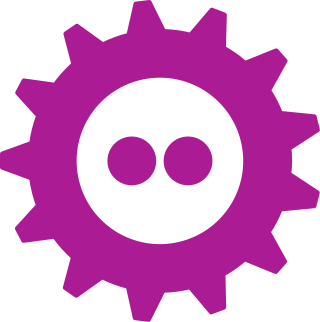In computing, a solution stack or software stack is a set of software subsystems or components needed to create a complete platform such that no additional software is needed to support applications. [1] Applications are said to "run on" or "run on top of" the resulting platform.
For example, to develop a web application, the architect defines the stack as the target operating system, web server, database, and programming language. Another version of a software stack is operating system, middleware, database, and applications. [2] Regularly, the components of a software stack are developed by different developers independently from one another.
Some components/subsystems of an overall system are chosen together often enough that the particular set is referred to by a name representing the whole, rather than by naming the parts. Typically, the name is an acronym representing the individual components. [3]
The term "solution stack" has, historically, occasionally included hardware components as part of a final product, mixing both the hardware and software in layers of support. [4] [5]
A full-stack developer is expected to be able to work in all the layers of the application (front-end and back-end). A full-stack developer can be defined as a developer or an engineer who works with both the front and back end development of a website, web application or desktop application. [6] This means they can lead platform builds that involve databases, user-facing websites, and working with clients during the planning phase of projects.

PostgreSQL, also known as Postgres, is a free and open-source relational database management system (RDBMS) emphasizing extensibility and SQL compliance. PostgreSQL features transactions with atomicity, consistency, isolation, durability (ACID) properties, automatically updatable views, materialized views, triggers, foreign keys, and stored procedures. It is supported on all major operating systems, including Linux, FreeBSD, OpenBSD, macOS, and Windows, and handles a range of workloads from single machines to data warehouses or web services with many concurrent users.
Web development is the work involved in developing a website for the Internet or an intranet. Web development can range from developing a simple single static page of plain text to complex web applications, electronic businesses, and social network services. A more comprehensive list of tasks to which Web development commonly refers, may include Web engineering, Web design, Web content development, client liaison, client-side/server-side scripting, Web server and network security configuration, and e-commerce development.

Free and Open source Software Developers' European Meeting (FOSDEM) is a non-commercial, volunteer-organized European event centered on free and open-source software development. It is aimed at developers and anyone interested in the free and open-source software movement. It aims to enable developers to meet and to promote the awareness and use of free and open-source software.

LAMP is an acronym denoting one of the most common software stacks for the web's most popular applications. Its generic software stack model has largely interchangeable components.

Catalyst is an open source web application framework written in Perl, that closely follows the model–view–controller (MVC) architecture, and supports a number of experimental web patterns. It is written using Moose, a modern object system for Perl. Its design is heavily inspired by frameworks such as Ruby on Rails, Maypole, and Spring.
The acronyms BAPP and BAMP refer to a set of open-source software programs commonly used together to run dynamic websites or servers. This set is a solution stack, and an open source web platform.
MAMP is a solution stack composed of free and open-source and proprietary commercial software used together to develop and run dynamic websites on Apple Macintosh computers.
An embedded database system is a database management system (DBMS) which is tightly integrated with an application software; it is embedded in the application. It is a broad technology category that includes:
The acronym WIMP is a solution stack of software, partially free and open source software, used to run dynamic Web sites on servers. The expansion is as follows:

LYME and LYCE are software stacks composed entirely of free and open-source software to build high-availability heavy duty dynamic web pages. The stacks are composed of:
The following outline is provided as an overview of and topical guide to the Perl programming language:
Jelastic is a cloud platform software vendor that provides multi-cloud Platform as a Service-based on container technology for hosting service providers, ISVs, telecommunication companies, enterprises and developers. The platform is available as public cloud in over 70 data centers, as well as virtual and on-premises servers. Jelastic provides support of Java, PHP, Ruby, Node.js, Python, Go environments, custom Docker containers and Kubernetes clusters.

MEAN is a source-available JavaScript software stack for building dynamic web sites and web applications. A variation known as MERN replaces Angular with React.js front-end, and another named MEVN use Vue.js as front-end.
The following outline is provided as an overview of and topical guide to MySQL:
The following outline is provided as an overview of and topical guide to web design and web development, two very related fields: